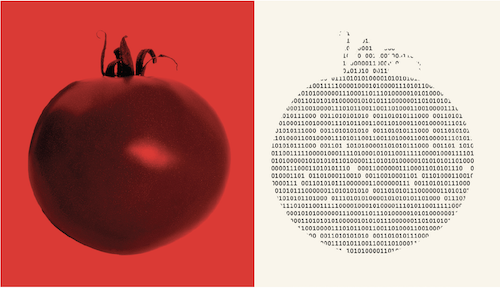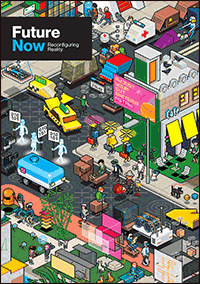Future Now
The IFTF Blog
Digital Twins
What if we could get better answers from what-if questions?
“What if we reduce the enclosure thickness two millimeters so we can make room for a bigger battery?”
“What if we shut down the air conditioning on the factory floor when people aren’t present?”
“What if we tell our customers to perform oil-system flushes on leased equipment less frequently than we currently specify?”
“What if” is a common question in every organization, because it’s the first step in optimizing existing processes or developing new ones. There are four main ways to answer a what-if question: We can rely on our imaginations. We can use our experience and historical data. We can run tests and analyze the data. And we can develop models and simulations to see what happens.
Often, using one or more of these methods can provide useful answers. But we won’t learn if the decision we make is good until we try it in the real world. That’s because these methods—visualization, experience, tests, and models—are more or less disconnected from the real world.
Here’s a what if: What if you could connect real things to virtual counterparts? If you had sensors attached to things, you could send the sensor measurements to software models of those things. You could then tune the models so they respond just like their real-life counterparts do. They become “digital twins” that operate in sync with their physical siblings.
When physical things acquire digital twins, and they become entangled with sensor data, new possibilities emerge:
1. X-ray Vision
Things in the real world are subject to variations in heat and humidity, mechanical wear, and other environmental insults. Dashboards with sensors and gauges on machines give us a limited keyhole view, but digital twin technology gives us 360-degree X-ray vision to see what’s going on under the hood. The digital twin becomes alive when it’s fed real-word, real-time data. Service teams can look at a digital twin on a display and see all the components and their vital signs. If a bearing is chattering and hot, it will appear bright red on the twin, prompting the service team to replace the bearing before it leads to a costly catastrophic failure. Digital twins will be combined with predictive algorithms to automatically generate preventive maintenance schedules, which will help avoid equipment downtime and customer dissatisfaction.

2. Increased Productivity
When Maserati was designing its Ghibli sports car, it used digital twin technology to connect development engineers’ designs to manufacturing engineers’ assembly factory designs. In essence, Maserati created a virtual car and virtual factory, which could accept and respond to data produced by their physical prototypes. As a result, the time-to-production dropped from the typical 30 months to 16 months.
A Siemens factory that makes computer-control systems in 1,000 different varieties has a nearly 0 percent defect rate, in large part because the entire factory has an identical digital twin that Siemens uses to design and test components and assembly equipment before the physical factory takes over. Today, some factories are requiring vendors to provide digital twins along with the components they supply.
3. Improved Products
Smart connected products are giving manufacturers unprecedented insight into how their products are being used. Incorporating digital twin technology into these connected vehicles, machines, consumer electronics, robots, and other manufactured equipment will change the nature of the buyer-seller relationship. Think of a construction company that buys or leases backhoes from a heavy equipment manufacturer. When the backhoes are outfitted with sensors that measure engine temperature, loads on moving parts, vibrations, component failures, noises, and so on, the data will be wirelessly transmitted as streams of data in real time to digital twin backhoes that respond in a realistic way to the data. The customer, as a data provider, and the manufacturer, who uses the data to make better backhoes, become partners who share a common goal—developing the best backhoe possible.
At the 2015 LiveWorx Technology Conference in Boston, the Internet of Things (IoT)/augmented reality platform provider PTC demonstrated a bicycle equipped with various sensors that fed data to a digital twin bike, which was shown to the audience on a screen. The digital bike moved and responded in sync with the physical bike that a rider was pedaling on stage. “The digital twin is a replication of the physical product,” Mike Campbell, PTC’s Executive Vice President of the CAD division, said at the event. “Today, as an engineer, when I design a product and send it out in the market, it sort of goes to the dark side of the moon. I don’t really know how it’s used. Unless something breaks and the customer gets angry, I don’t know what happens. A smart connected product gives me a chance to understand how the product is being used in the real world and to further optimize the product to make sure it is meeting the requirements and is successful in the environment where it is being used.”
4. Optimized Health
People (and other living things) can have digital twins, too. Like an advanced Fitbit, your digital twin will know when you sleep and exercise, what you eat, your hormone, cholesterol, and blood sugar levels, and more. Your digital twin’s virtual physiology will respond in a realistic way to these measurements. You will be able to press the fast-forward button to generate your extrapolated health profile and identify problems down the road (“Type 2 diabetes in 3.5 years”). Like a retirement income calculator, the system will prescribe a customized dietary and activity regimen to ensure optimal health.
The Future of the Digital Twin
In 10 years every connected thing will have a digital twin pulsing in the cloud. It will be connected to its physical twin, mirroring its behavior. The digital twin will be replicated and connected in new ways to other digital twins, to be used in meta-simulations to test new supply chains, factory floor plans, and business models. Digital twins will be connected to security-focused “digital ghosts” that replicate control systems and identify hackers’ attempts to spoof sensor readings and disrupt systems, as well as be able to safely run penetration tests. The digital twin will be the foundation of the ultimate what-if system, providing answers that come closer to being right than ever before.
 FUTURE NOW—Reconfiguring Reality
FUTURE NOW—Reconfiguring Reality
This third volume of Future Now, IFTF's print magazine powered by our Future 50 Partnership, is a maker's guide to the Internet of Actions. Use this issue with its companion map and card game to anticipate possibilities, create opportunities, ward off challenges, and begin acting to reconfigure reality today.
About IFTF's Future 50 Partnership
Every successful strategy begins with an insight about the future and every organization needs the capacity to anticipate the future. The Future 50 is a side-by-side relationship with Institute for the Future: a partnership focused on strategic foresight on a ten-year time horizon. With 50 years of futures research in society, technology, health, the economy, and the environment, we have the perspectives, signals, and tools to make sense of the emerging future.
For More Information
For more information on IFTF's Future 50 Partnership and Tech Futures Lab, contact:
Sean Ness | sness@iftf.org | 650.233.9517



